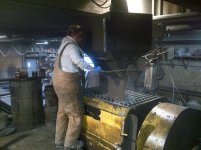Darren Bedford
PCS Member
Today I was at Baker Vault Co in Queensville ON, which is less than a hour North of Toronto.
I took a bunch of photo of them pouring concrete burial vaults.
The vault molds are upside down but the lids molds are upright.
They line them up 4 at a time along the crane tracks.
The person upstairs mixing works the chemicals, sand, gravel, cement mix and water.
The people pouring work the cement hopper, vibrators, fork lift and trowels.
The concrete is mixed on the upper level of the cement shop.
The sand and gravel travel along a belt from the supply room and gets dumped into a bucket which is hosted up and dumped into the cement mixer.
The cement mix travels from the cement silo, fills a bucket and gets dumped into the cement mixer. The person mixing adds the water and hardening chemicals as well.
After the concrete is mixed completely, it is dumped in the hopper.
The hopper is hoisted and moved along the tracks and placed over the vault molds. They open the hopper and pour the cement into the molds.
They have heavy duty vibrators hung on the sides of the molds to insure a air free mold.
They then finish the bottom of the vault to a smooth flat surface.
The vault lids are then placed on wooden boards across the bases so they can be filled with cement.
After pouring the lids the surfaces are smoothed out.
The fork lift lifts both the lid and base to the drying racks.
Another 4 vaults are then started. They can do up to 16 vaults a day.
The next day they are dry enough to strip the molds. After stripping, they are put outside to let the concrete fully cure which takes many days.
Before the concrete is fully cured, they call them "green", which means soft.
I will provide a photo session of them stripping vaults in a upcoming part 2.
Enjoy the photos,
Darren
All photos taken by Darren Bedford 12-18-12
Baker Vault Co. Queensville ON Canada
Requested and Permission by Jen DIGGER Baker
I took a bunch of photo of them pouring concrete burial vaults.
The vault molds are upside down but the lids molds are upright.
They line them up 4 at a time along the crane tracks.
The person upstairs mixing works the chemicals, sand, gravel, cement mix and water.
The people pouring work the cement hopper, vibrators, fork lift and trowels.
The concrete is mixed on the upper level of the cement shop.
The sand and gravel travel along a belt from the supply room and gets dumped into a bucket which is hosted up and dumped into the cement mixer.
The cement mix travels from the cement silo, fills a bucket and gets dumped into the cement mixer. The person mixing adds the water and hardening chemicals as well.
After the concrete is mixed completely, it is dumped in the hopper.
The hopper is hoisted and moved along the tracks and placed over the vault molds. They open the hopper and pour the cement into the molds.
They have heavy duty vibrators hung on the sides of the molds to insure a air free mold.
They then finish the bottom of the vault to a smooth flat surface.
The vault lids are then placed on wooden boards across the bases so they can be filled with cement.
After pouring the lids the surfaces are smoothed out.
The fork lift lifts both the lid and base to the drying racks.
Another 4 vaults are then started. They can do up to 16 vaults a day.
The next day they are dry enough to strip the molds. After stripping, they are put outside to let the concrete fully cure which takes many days.
Before the concrete is fully cured, they call them "green", which means soft.
I will provide a photo session of them stripping vaults in a upcoming part 2.
Enjoy the photos,
Darren
All photos taken by Darren Bedford 12-18-12
Baker Vault Co. Queensville ON Canada
Requested and Permission by Jen DIGGER Baker
Attachments
-
 BV Digger filling the bucket with sand and gravel.jpg47.8 KB · Views: 712
BV Digger filling the bucket with sand and gravel.jpg47.8 KB · Views: 712 -
 BV Digger filling the mixer with cement mix.jpg57 KB · Views: 681
BV Digger filling the mixer with cement mix.jpg57 KB · Views: 681 -
 BV Digger filling cement mixer.jpg52.7 KB · Views: 665
BV Digger filling cement mixer.jpg52.7 KB · Views: 665 -
 BV Digger pouring sand and gravel in mixer.jpg63.6 KB · Views: 795
BV Digger pouring sand and gravel in mixer.jpg63.6 KB · Views: 795 -
 BV Doug and Brian with cement hopper.jpg64.7 KB · Views: 1,155
BV Doug and Brian with cement hopper.jpg64.7 KB · Views: 1,155 -
 BV Doug and Brian pouring vaults.jpg65.6 KB · Views: 823
BV Doug and Brian pouring vaults.jpg65.6 KB · Views: 823










